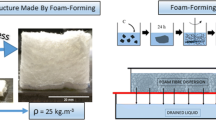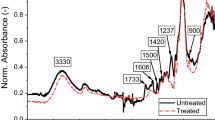Abstract
Fibre-laden liquid foams are used in the production process of novel non-woven fibrous materials, employed for example for thermal or acoustic insulation. Here we present an experimental investigation of the stability of such foams. We find that on a time-scale of a few minutes the presence of fibres does not alter the drainage properties of the foam. On a longer time-scale fibres slow down drainage, mainly due to their slowing down of coarsening. The drying of our aged samples leads to a fibre network with a fibre concentration profile that appears to be determined by gravity. Our experiments were performed using fibre concentrations of a few percent, as relevant also to the foam-laid forming of paper, where aqueous foam instead of water is used as a carrier medium for fibres .









Similar content being viewed by others
References
Abràmoff MD, Magalhães PJ, Ram SJ (2004) Image processing with ImageJ. Biophoton Int 11(7):36–42
Alimadadi M, Uesaka T (2016) 3D-oriented fiber networks made by foam forming. Cellulose 23(1):661–671
Al-Qararah AM, Hjelt T, Koponen A, Harlin A, Ketoja JA (2013) Bubble size and air content of wet fibre foams in axial mixing with macro-instabilities. Colloids Surf A Physicochem Eng Asp 436:1130–1139
Al-Qararah AM, Hjelt T, Koponen A, Harlin A, Ketoja JA (2015) Response of wet foam to fibre mixing. Colloids Surf A Physicochem Eng Asp 467:97–106
Britan A, Liverts M, Ben-Dor G, Koehler SA, Bennani N (2009) The effect of fine particles on the drainage and coarsening of foam. Colloids Surf A Physicochem Eng Asp 344(1):15–23
Cantat I, Cohen-Addad S, Elias F, Graner F, Höhler R, Flatman R, Pitois O, Rouyer F, Saint-Jalmes A (2013) Foams: structure and dynamics. Oxford University Press, Oxford
Denkov ND, Tcholakova S, Golemanov K, Ananthpadmanabhan KP, Lips A (2009) The role of surfactant type and bubble surface mobility in foam rheology. Soft Matter 5(18):3389–3408
Dubash N, Frigaard IA (2007) Propagation and stopping of air bubbles in Carbopol solutions. J Non-Newton Fluid Mech 142(1):123–134
García-Moreno F, Tobin ST, Mukherjee M, Jiménez C, Solórzano E, Kumar GV, Hutzler S, Banhart J (2014) Analysis of liquid metal foams through X-ray radioscopy and microgravity experiments. Soft Matter 10(36):6955–6962
Haffner B, Khidas Y, Pitois O (2015) The drainage of foamy granular suspensions. J Colloid Interface Sci 458:200–208
Haffner B, Dunne F, McDermott D, Hutzler S (2016) Analysis of controlled free drainage experiments of aqueous foams (to be submitted in 2016)
Joung CG, Phan-Thien N, Fan XJ (2002) Viscosity of curved fibers in suspension. J Non-Newton Fluid Mech 102(1):1–17
Koczo K, Lobo LA, Wasan DT (1992) Effect of oil on foam stability: aqueous foams stabilized by emulsions. J Colloid Interface Sci 150(2):492–506
Koehler SA, Hilgenfeldt S, Stone HA (1999) Liquid flow through aqueous foams: the node-dominated foam drainage equation. Phys Rev Lett 82(21):4232
Koehler SA, Hilgenfeldt S, Stone HA (2000) A generalized view of foam drainage: experiment and theory. Langmuir 16(15):6327–6341
Kraynik AM, Reinelt DA, van Swol F (2004) Structure of random foam. Phys Rev Lett 93(20):208301
Krichevsky O, Stavans J (1992) Coarsening of two-dimensional soap froths in the presence of pinning centers. Phys Rev B 46(17):10579
Lesov I, Tcholakova S, Denkov N (2014) Factors controlling the formation and stability of foams used as precursors of porous materials. J Colloid Interface Sci 426:9–21
Lundell F, Söderberg LD, Alfredsson PH (2011) Fluid mechanics of papermaking. Ann Rev Fluid Mech 43:195–217
Rodrigues RT, Rubio J (2003) New basis for measuring the size distribution of bubbles. Miner Eng 16(8):757–765
Salonen A, Lhermerout R, Rio E, Langevin D, Saint-Jalmes A (2012) Dual gas and oil dispersions in water: production and stability of foamulsion. Soft Matter 8(3):699–706
Verbist G, Weaire D, Kraynik AM (1996) The foam drainage equation. J Phys Condens Matter 8(21):3715
Weaire D, Hutzler S (2001) The physics of foams. Oxford University Press, Oxford
Whyte D, Haffner B, Tanaka A, Hjelt T, Hutzler S (2016) The interactions of fibres with soap films (to be submitted in 2016)
Acknowledgments
We would like to thank T. Hjelt and J. Ketoja, both at VTT Espoo Finland, for many engaging discussions. This publication has emanated from research supported in part by a research grant from Science Foundation Ireland (SFI) (Grant no. 13/IA/1926). We also acknowledge the support of the MPNS COST Actions (European Cooperation in Science and Technology) MP1106 “Smart and green interfaces” and MP1305 “Flowing matter” and the European Space Agency ESA, Project microG-Foam, AO-99-075 and contract 4000115113, “Soft Matter Dynamics”. We thank project students M. McGrath and D. McDermott for some experimental contributions to this work.
Author information
Authors and Affiliations
Corresponding author
Rights and permissions
About this article
Cite this article
Haffner, B., Dunne, F.F., Burke, S.R. et al. Ageing of fibre-laden aqueous foams. Cellulose 24, 231–239 (2017). https://doi.org/10.1007/s10570-016-1100-1
Received:
Accepted:
Published:
Issue Date:
DOI: https://doi.org/10.1007/s10570-016-1100-1




